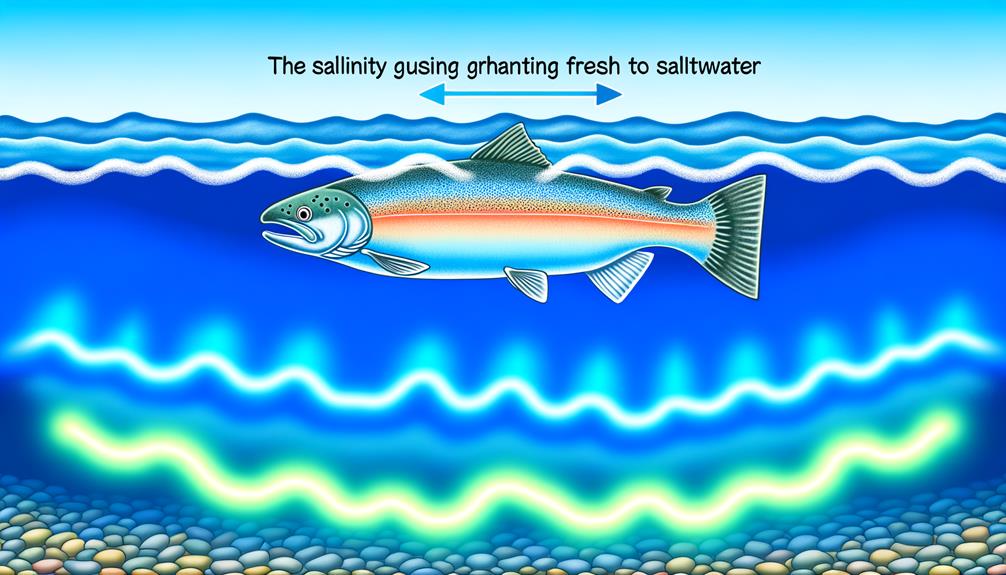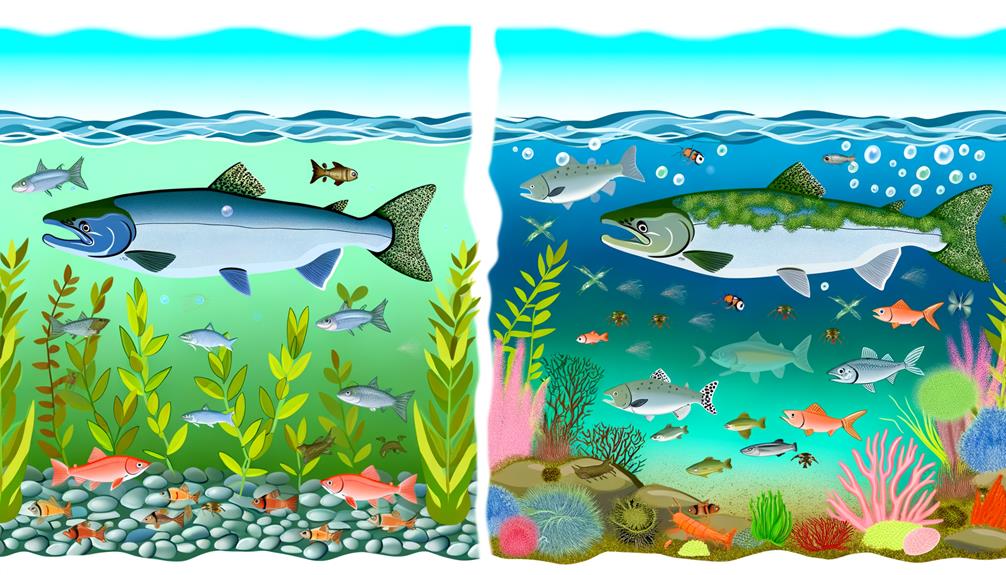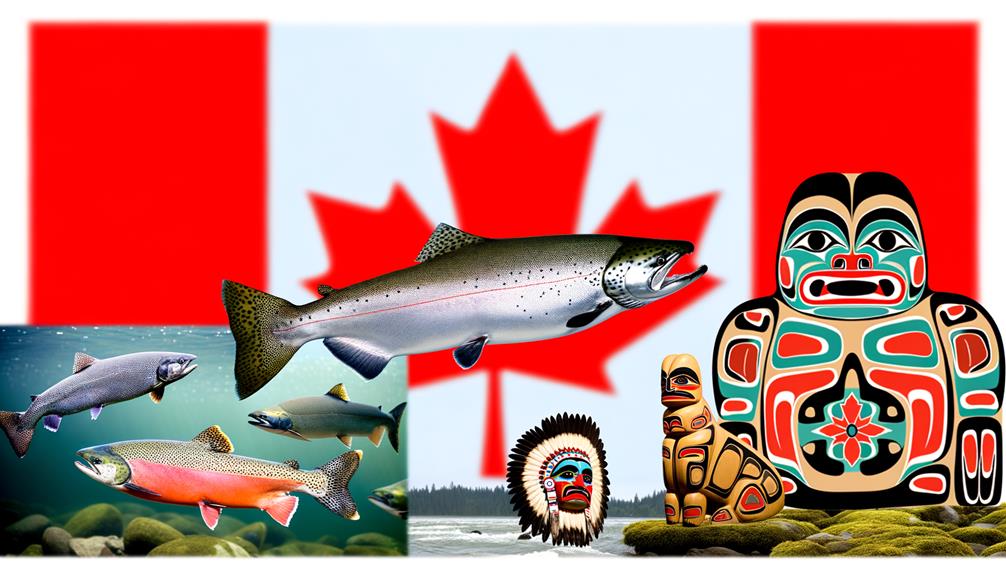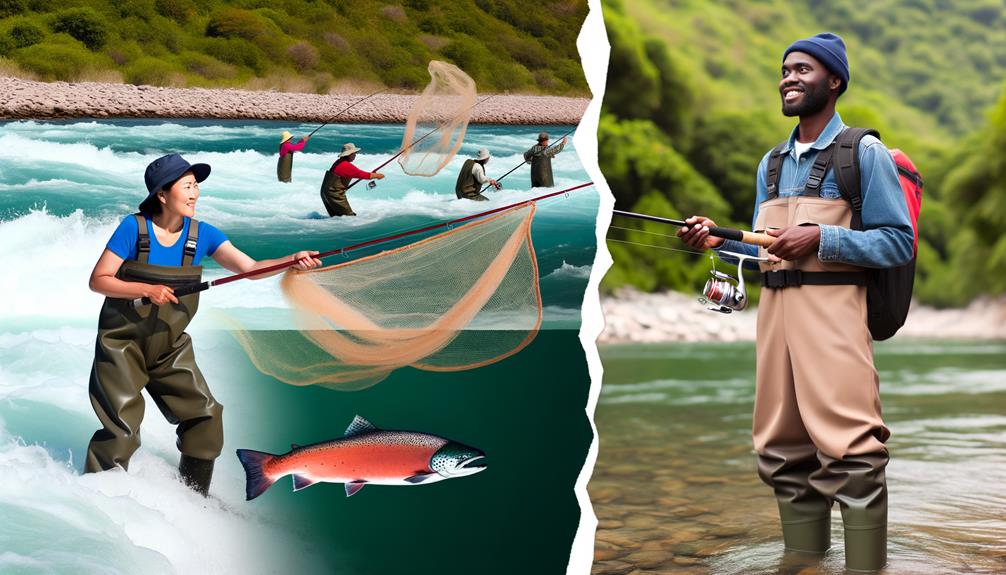The unique life cycle of salmon, which involves a remarkable transition between freshwater and saltwater habitats, has long intrigued scientists, ecologists, and fish enthusiasts alike.
This anadromous journey from freshwater birthplaces to the saltwater ocean, and back again for reproduction, raises an interesting question: are salmon fundamentally freshwater or saltwater fish?
As we explore this question, we will consider the environmental adaptations of salmon, their significance in ecosystems, and the pressing conservation concerns that surround them.
Key Takeaways
- Salmon are both freshwater and saltwater fish, born in freshwater and migrating to the ocean as they mature.
- Physiological adaptations aid salmon in osmoregulation, allowing them to thrive in varying water conditions.
- They return to their natal freshwater streams for spawning, demonstrating remarkable homing behavior.
- Human-induced changes like dams and pollution can disrupt this critical migration process, threatening salmon survival.
Understanding Salmon Habitat
In comprehending the habitat of salmon, it is crucial to note that these anadromous fish traverse both freshwater and saltwater environments, exhibiting unique physiological adaptations for osmoregulation, which facilitate their survival amidst varying salinity levels. Born in freshwater rivers, salmon migrate to the ocean, becoming true saltwater fish as they mature, feeding and growing in the nutrient-rich marine ecosystem. Their osmoregulatory abilities enable them to switch from absorbing salts in freshwater to excreting them in saltwater, a remarkable feat of physiological resilience.
Understanding the salmon habitat is not just a matter of scientific curiosity; it has profound implications for conservation. Changes in habitat, particularly human-induced alterations like dams or pollution, can disrupt salmon migration and impede spawning success. It's essential to grasp how these changes can degrade the conditions salmon need for survival. For instance, dams can hinder their upstream migration, while pollution could affect water quality, threatening both their freshwater birthplaces and their ocean feeding grounds. Therefore, knowledge about the salmon habitat, both freshwater and saltwater, is integral to the conservation strategies aimed at ensuring the continued existence of these extraordinary migratory fish.
Life Cycle of Salmon
The life cycle of salmon is a fascinating biological phenomenon characterized by distinct stages and intricate physiological changes.
It commences with the salmon's reproductive journey, a unique voyage from freshwater to saltwater habitats and back again, aimed at ensuring the next generation.
The stages of salmon growth, from egg to smoltification and finally, to spawning adults, are accompanied by significant morphological transformations, allowing them to adapt to varying water conditions.
Salmon's Reproductive Journey
Embarking on a remarkable journey, salmon, known as anadromous fish, hatch in freshwater, subsequently migrate to the ocean, and ultimately return to their birthplace in freshwater to spawn, exhibiting distinct life stages from eggs to alevins, fry, smolt, adults, and finally spawning adults.
The reproductive journey of salmon is a cyclical process, deeply ingrained in their biology. Their exceptional homing behavior, a trait of unerring precision, leads them back to their natal streams for spawning. During this crucial phase, female salmon construct nests, or 'redds', depositing and fertilizing eggs.
This miraculous voyage of birth, growth, migration, and return is not just vital for salmon's survival, but also plays a significant role in maintaining ecosystem health, nutrient cycling, and sustaining various species in the environment.
Stages in Salmon Growth
Spanning seven intricate stages – from egg, to alevin, fry, parr, smolt, adult, and finally, spawning adult – the life cycle of salmon is a fascinating study of growth, adaptation, and survival in diverse environments.
- Beginning as an egg in freshwater streams, each salmon embarks on a journey of transformation.
- As a juvenile, the fry then smolt, experiencing significant growth and physical changes in preparation for their oceanic sojourn.
- As adults, they return to their natal freshwater habitats to reproduce, or spawn, thereby completing their life cycle.
This cycle, marked by distinct stages, underscores the salmon's unique ability to adapt between freshwater and saltwater habitats, reflecting a profound evolutionary strategy that promotes species survival and continuity.
Salmon's Sensory Abilities

Possessing a remarkable olfactory prowess, salmon can detect a single drop of scent in a vast expanse, making their sense of smell an essential tool for survival and navigation throughout their life cycle. This acute sense of smell is vital in guiding them towards abundant food sources and, importantly, their natal spawning grounds.
In the context of their migration patterns, salmon's olfactory abilities allow them to memorize the unique smell of their birthplace, facilitating their return years later. Notably, the Atlantic salmon exemplifies this exceptional olfactory sensitivity and precision.
The significance of the salmon's sense of smell extends beyond navigation. It plays a critical role in their social interactions, predator avoidance, and prey detection, contributing to their overall survival. Thus, olfaction, as part of the salmon's sensory abilities, is integral to the complex life cycle of these remarkable creatures.
This understanding of salmon's sensory abilities, specifically their olfactory prowess, provides a fascinating insight into their behaviors and survival strategies. It underscores the intricate balance of nature and highlights the importance of conservation efforts to preserve the habitats that sustain these intricate sensory systems.
The Colour Changing Phenomenon
In addition to their remarkable olfactory capabilities, salmon exhibit an intriguing color-changing phenomenon throughout their lifecycle, shifting from light-colored juveniles to silvery blue adults and eventually transforming into red-spotted spawning adults. These color changes serve as a testament to the salmon's adaptability and resilience, reflecting their survival strategies and migration patterns.
- Mating Displays: The transition to a red-spotted guise is not merely a spectacle but serves a significant purpose in salmon reproduction. The vibrant hue signals readiness to mate, attracting potential partners and ensuring successful propagation.
- Camouflage: The color changes also function as a camouflage mechanism. As juveniles, the light color helps salmon blend with the shallow waters, providing protection from predators. The silvery blue of adulthood is well-suited to the open ocean, aiding survival during their migratory journey.
- Migration Patterns and Survival Strategies: The distinct color phases in a salmon's life cycle provide invaluable insights into their behavior, migration patterns, and survival strategies. Through understanding these color changes, we can appreciate their adaptive capabilities, giving us a deeper understanding of this remarkable species.
In essence, the color-changing phenomenon in salmon is a fascinating interplay of biology and environment, underpinning their life cycle and survival strategies.
Salmon: A Keystone Species

As a keystone species, salmon exert a profound influence on the health and balance of their ecosystems. Their migration and spawning behaviors foster biodiversity and nutrient transfer. Their cyclical journey between freshwater and saltwater habitats, traversing rivers, streams, and oceans, marks them as integral contributors to the vitality of both aquatic and terrestrial ecosystems.
The spawning grounds of salmon, typically freshwater habitats, are enriched by the return of adult salmon. The death and decomposition of these mature salmon post-spawning ensure nutrient transfer, providing sustenance for other species in the ecosystem. This organic matter, rich in nitrogen, sulfur, and phosphorus, infiltrates the water and soil, bolstering the productivity of the habitat.
The presence of healthy salmon populations can serve as a bio-indicator for the overall health and biodiversity of an ecosystem. A thriving salmon population suggests a robust, balanced ecosystem, where various species coexist and benefit from each other. Hence, conservation efforts focusing on safeguarding salmon habitats also contribute significantly to preserving the integrity and diversity of these ecosystems. Their pivotal role underscores the interconnectedness of species and habitats, highlighting the need for holistic ecological strategies.
Threats to Salmon Survival
Despite their integral role in maintaining ecosystem balance, salmon populations worldwide are facing escalating threats, primarily from pollution, habitat destruction, and overfishing. These challenges are exacerbated by climate change, which is altering habitats and migration patterns, leading to increased vulnerability of salmon populations.
- Pollution and Habitat Destruction: Industrial waste and agricultural runoff pollute the waters that salmon inhabit. Habitat destruction, resulting from deforestation and urbanization, eradicates the natural environment essential for salmon survival.
- Overfishing: Unregulated fishing practices and high demand for salmon in international markets lead to overfishing, threatening the sustainability of salmon populations.
- Climate Change, Parasites, and Dams: Climate change introduces unpredictable water temperature fluctuations, disrupting salmon's life cycle. Parasites, often flourishing due to warmer waters, pose significant health risks. Furthermore, dams obstruct salmon migration routes, impeding their ability to spawn.
Addressing these threats is critical to ensure the survival of salmon. As a keystone species, their decline could have profound impacts on the larger ecosystem, underscoring the importance of concerted conservation efforts. By understanding these challenges, we can better appreciate the complex struggles salmon face in their lifelong journey between fresh and saltwater habitats.
Role of Salmon in Canadian Heritage

The role of salmon in Canadian heritage is multifaceted, spanning economic, cultural, and culinary spheres. Salmon have significantly contributed to the economic prosperity of British Columbia through commercial and recreational fisheries, providing substantial benefits to coastal communities.
In addition, as the official provincial fish, they embody cultural significance, with traditional practices such as salmon smoking being closely tied to Canadian heritage.
Salmon's Cultural Significance
How intrinsic is salmon to the Canadian heritage, especially within the First Nations communities? The cultural importance of salmon is deeply embedded in the fabric of these communities. It is not merely a food source, but a symbol of their rich cultural heritage.
- Salmon serves as a primary food source for many First Nations communities, underscoring its cultural importance and contributing to their sustenance and survival.
- The fish holds symbolic significance in the Pacific Northwest, embodying the heritage and traditions of these communities. It is a symbol of life, abundance, and renewal.
- As the official provincial fish of British Columbia, salmon's status highlights its cultural importance, reflecting its role in local customs, festivities, and culinary traditions.
The cultural significance of salmon in Canadian heritage is undeniably profound.
Economic Impact of Salmon
In examining the role of salmon in Canadian heritage, one cannot overlook its significant contribution to the economic prosperity of coastal communities, particularly in British Columbia. Salmon has been central to the early economic development of this region, supporting both commercial and recreational fisheries.
This iconic fish is not only a cultural emblem, as the official provincial fish of British Columbia, but also an economic powerhouse. In terms of economic impact, salmon contributes substantially through exports, tourism, and employment opportunities. The production of smoked salmon, a delicacy deeply interwoven with Canadian heritage, further underscores the economic value of salmon.
Thus, the vitality of salmon transcends its ecological role, shaping the economic landscape of coastal communities in British Columbia.
Osmoregulation in Salmon
Navigating between freshwater and saltwater environments, salmon exhibit a remarkable ability to control their bodily fluids through a process known as osmoregulation. This biological phenomenon, initiated during the smolt phase, is vital for juvenile salmon preparing for sea migration.
The transformation involves several biological adaptations:
- Smolts increase water intake, effectively acclimatizing their bodies to the higher salinity in saltwater environments.
- The production of urine is reduced, thereby further helping the fish conserve essential bodily fluids.
- The direction of the gill pump is reversed, enabling the salmon to excrete excess salts while maintaining necessary fluid levels.
These changes in osmoregulation are not permanent; they revert when mature salmon return to their freshwater spawning grounds for reproduction.
Indeed, dissected salmon gills provide a close-up view of these fascinating osmoregulatory adaptations, showcasing the complexity of the salmon's life cycle and its interaction with different water environments. As part of a larger ecological community, understanding these processes contributes to our sense of belonging, reinforcing the interconnectedness of all life on earth.
Salmon in Commercial and Recreational Fishing

Moving from the intricate biological mechanisms of osmoregulation to human interactions, salmon, especially Pacific salmon, are a crucial part of both commercial and recreational fishing industries. Commercial fishing for salmon is a significant economic activity in regions like British Columbia, providing livelihoods for many communities. Equally, recreational fishing for salmon is popular due to the species' fighting spirit and delicious taste, contributing to tourism and local economies.
Sustainable practices and regulations are pivotal in these industries to ensure the continued health and viability of salmon populations. Quotas are often set to manage catch volumes and protect wild stocks. These regulations are underpinned by scientific understanding of salmon life cycles and their environmental requirements.
| Type of Fishing | Sustainability Practices | Economic Impact |
|---|---|---|
| Commercial | Quotas, Regulations | Provides livelihoods |
| Recreational | Catch-and-release | Boosts tourism |
Frequently Asked Questions
Is Salmon a Freshwater or Saltwater?
Salmon, exhibiting remarkable adaptations, inhabit both freshwater and saltwater during their lifespan. Their diet and migration patterns vary with these habitats. Notably, they breed in freshwater, showcasing their unique ability to thrive in diverse environments.
Are Salmon Farmed in Fresh or Saltwater?
Salmon are farmed in both fresh and saltwater environments. This adapts to their life cycle needs, utilizes varied farming techniques, addresses sustainability concerns, and has significant economic impact with differing nutrient profiles and health implications.
How Do Salmon Go From Freshwater to Saltwater?
Salmon migration involves a remarkable osmoregulation adaptation, transitioning from freshwater to saltwater during the smoltification process. This estuary transition is influenced by various factors, including potential predators, ensuring their survival in diverse aquatic environments.
Are Salmon Caught in Freshwater?
Salmon, undergoing their intricate migration process, are indeed caught in freshwater. Anglers, utilizing specific catching techniques, target these fish, mindful of potential freshwater predators, fishing regulations, and the salmon's unique lifespan.
Conclusion
In conclusion, salmon represent a marvel of nature, exhibiting an extraordinary ability to navigate different environments and withstand varying salinity. Their existence underpins the health of aquatic ecosystems, contributing significantly to biodiversity.
However, escalating threats necessitate stringent conservation measures. These anadromous creatures, through their unique lifecycle and habitat adaptability, serve as a poignant reminder of the intricate, interconnected web of life that spans from the freshwater streams to the vast oceanic expanses.



